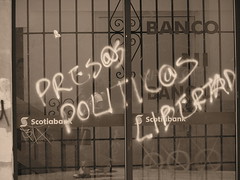Oaxaca Roundup
Despite all the fun we've had with my new do, it's not all peaches and cream in Oaxaca. The city, as always, is roiled in contradiction.
By outward appearances things are good. Tourism is up overall, though there's a momentary, post-spring break lull now before the summer season begins in earnest (this from a long time Spanish teacher who tells me that May enrollment is always tranquilo before June and July bring the summer backpackers and vactioners to town). Cafes and galleries are all open, and there's plenty of street art, music, and fireworks to be enjoyed on the weekends.
Get beyond the main blocks of the centro, however, and things are slightly different. Shots were fired this week between rival gangs at the UABJO, the big, ever turbulent Benito Juarez University in Oaxaca City. You may remember this account of elections for the director of the law school, which involved some 200 police in riot gear. It seems now that the fighting is between the former general director of the Facultad de Derecho y Ciencias Sociales and the man who attempted to replace him. It's harder to follow then the election results coming out of Zimbabwe, and fighting broke out on campus this past Tuesday. Police responded with gas and carted people away.
On a different, and fairly disturbing note, two indigenous radio show hosts were reported murdered Wednesday in the Triqui town of San Juan Copala read an English article here). Here's a blurb from the Oaxaca Study Action Group which summarizes the events, though I can't vouch for accuracy:
Two indigenous triqui women who worked at the community radio station La Voz que Rompe el Silencio (The Voice that Breaks the Silence), in the autonomous municipality of San Juan Copala (Mixteca region), were shot and murdered while on their way to Oaxaca city to participate in the State Forum for the Defense of the Rights of the Peoples of Oaxaca. Three other people were injured.
. . . According to prelimary reports, the women had left the station, which is part of the Network of Indigenous Community Radio Stations of the Southeast (Red de Radios Comunitarias Indígenas del Sureste), around 1:00 PM. They were travelling in a truck on their way to Oaxaca city, but were ambushed on the outskirts of the community Llano Juarez.
The two community radio activists were supposed to coordinate the working group for Community and Alternative Communication: Community Radio, Video, Press, and Internet, at the State Forum for the Defense of the Rights of the People of Oaxaca, which was to begin today (Wednesday) in the auditorium of Seccion 22 of the teachers union in Oaxaca.
This obviously has people concerned, though most of the chatter is limited to the Internet, as far as I've seen, and not any actual activity on the streets.
In the meantime, a pair of public school teachers I've spoken with are dreading the upcoming, annual teacher planton scheduled for May. For those who don't know, the teacher strike of 2006 was unusual not for the strike itself but for the severe government response and ensuing community resistance. The teachers' union strikes every year to demand pay and benefits increases, as well as school supplies, school infrastructure, and greater resources for students. Each year the demands are met with a show of resistance by the government, the teachers camp in the zocalo for a month, and then everybody agrees to settle. Not so in 2006, but most of us know that story by now. If not, click here and here for background.
One of the reasons teachers may not be looking forward to the event is because their attendance is compulsory, including the part where everybody sleeps on the cold stones of the zocalo overnight or takes turns keeping vigil. One more example of political might in Oaxaca: teachers don't take to the streets simply to support the cause, but because their livelihoods depend on it. Much like government employees who are required to sit in the amphitheater seats every year for the Guelaguetza: the governor makes sure there are no empty spaces in front of the cameras.
One last item of interest in Oaxaca right now: security patrols have increased significantly in the past two weeks. Convoys of pickup trucks run in threes throughout the city, loaded down with the black clad, machine gun toting security agents of the Federal Preventive Police. The increase in forces, some 150 patrols, coincides with the appointment of a new director of the PFP (Spanish initials), and is said to be specific to Oaxaca. My guess is it has to do with increased drug violence, but is also inextricably related to whatever madness is going on with the high profile kidnappings of businessmen in the city over Semana Santa (Easter week). I haven't heard anything recently, but the guesswork ran the gamut from pointing the finger at disgruntled terrorists to the governor himself disappearing people who may know too much or have simply become inconvenient to have around. Either way, it makes for interesting reading.
Okay. Gotta go eat fresh tamales from the organic market. So it's not all bad in Oaxaca after all. Like I said, a city of contradictions.



|